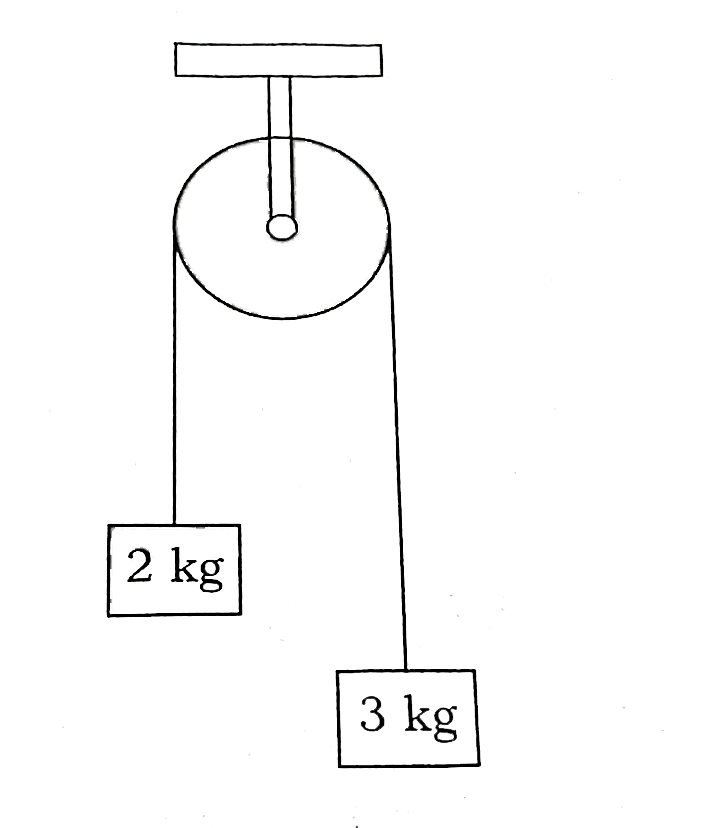A substance breaks down under a stress of 105 Pa. If the density of the substance is 2×103kgm3, find the minimum length of the wire made of this substance which will break under its own weight (g=10ms2)
10m
2.5m
4m
5m
To find the minimum length of the wire made of the given substance that will break under its own weight, we can follow these steps:
Step 1: Understand the relationship between stress, force, and area
Stress (σ) is defined as the force (F) applied per unit area (A):
σ=FA
Step 2: Identify the force acting on the wire
The force acting on the wire due to its own weight can be expressed as:
F=mg
where m is the mass of the wire and g is the acceleration due to gravity.
Step 3: Relate mass to density and volume
The mass m of the wire can be expressed in terms of its density (ρ) and volume (V):
m=ρV
For a wire of length L and cross-sectional area A, the volume V is given by:
V=A⋅L
Thus, we can write:
m=ρAL
Step 4: Substitute mass into the force equation
Substituting the expression for mass into the force equation gives:
F=ρALg
Step 5: Substitute force into the stress equation
Now we can substitute this expression for force into the stress formula:
σ=ρALgA
This simplifies to:
σ=ρLg
Step 6: Solve for the length of the wire
Rearranging the equation to solve for L gives:
L=σρg
Step 7: Substitute the known values
Now we can substitute the given values into the equation:
- Stress, σ=105Pa
- Density, ρ=2×103kg/m3
- Acceleration due to gravity, g=10m/s2
Substituting these values:
L=105(2×103)(10)
Step 8: Calculate the length
Calculating the denominator:
2×103×10=2×104
Now substituting back into the equation for L:
L=1052×104=102=5m
Conclusion
The minimum length of the wire that will break under its own weight is:
5m
---
Stress (σ) is defined as the force (F) applied per unit area (A):
σ=FA
The force acting on the wire due to its own weight can be expressed as:
F=mg
where m is the mass of the wire and g is the acceleration due to gravity.
The mass m of the wire can be expressed in terms of its density (ρ) and volume (V):
m=ρV
For a wire of length L and cross-sectional area A, the volume V is given by:
V=A⋅L
Thus, we can write:
m=ρAL
Substituting the expression for mass into the force equation gives:
F=ρALg
Now we can substitute this expression for force into the stress formula:
σ=ρALgA
This simplifies to:
σ=ρLg
Rearranging the equation to solve for L gives:
L=σρg
Now we can substitute the given values into the equation:
- Stress, σ=105Pa
- Density, ρ=2×103kg/m3
- Acceleration due to gravity, g=10m/s2
L=105(2×103)(10)
Calculating the denominator:
2×103×10=2×104
Now substituting back into the equation for L:
L=1052×104=102=5m
The minimum length of the wire that will break under its own weight is:
5m
Topper's Solved these Questions
- RACEBook:ALLENChapter:RACEExercise:Basic Maths (Trigonometry)
Explore 22 Videos
- RACEBook:ALLENChapter:RACEExercise:Basic Maths (Differentiation)
Explore 38 Videos
- RACEBook:ALLENChapter:RACEExercise:Race 21
Explore 5 Videos
- NEWTONS LAWS OF MOTIONBook:ALLENChapter:NEWTONS LAWS OF MOTIONExercise:EXERCISE-III
Explore 28 Videos
- SIMPLE HARMONIC MOTIONBook:ALLENChapter:SIMPLE HARMONIC MOTIONExercise:Example
Explore 1 Video
Similar Questions
A substance breaks down under a stress of 105Pa. If the density of the wire is 2×103kg/m3, find the minimum length of the wire which will break under its own weight (g=10ms−12).
View SolutionA material beaks up under a stress of 20×105N/m2. If the density of the material is 2.5×103kg/m3, calculate the length of a wire made of this material, which on hanging may break under its own weight. (g=9.8m/s2)
View SolutionA stress of 106N/m2 is required for breaking a material. If the density of the material is 3×103Kg/m3, then what should be the minimum length of the wire made of the same material so that it breaks by its own weight (g=10m/s2)
View SolutionThe breaking stress for a metal is 9×1010Nm−2 The density of the metal is 9000kgm−3 . If g=10Nkg−1 , the maximum length of the wire made of this metal which may be suspended without breaking is 10k m . Find the value of k.
View SolutionThe breaking stress for a substance is 106N/m2. What length of the wire of this substance should be suspended vertically so that the wire breaks under its own weight? (Given: density of material of the wire =4×103kg/m3 and g=10ms−2)
View SolutionThe breaking stress for a substance is 106N/m2. What length of the wire of this substance should be suspended verticaly so that the wire breaks under its own weight? (Given: density of material of the wire =4×103kg/m3 and g=10ms−12)
View SolutionTwo blocks of masses 2 kg and 3kg are connected by a metal wire going over a smoother pulley as shown in figure. The breaking stress of the steel is 2×109Nm−2. What would be the minimum radius of the wire used if it not to break ? Take ,g=10ms−2

View SolutionThe half life period for the decomposition of a substance is 2.5 hours. If the initial weight of the substance is 160 g, how much of the substance will be left after 10 hours?
View SolutionA bar magnet made of steel has a magnetic moment of 2.5Am2 and amass of 6.6×10−5kg. If the density of steel is 7.9×103kgm−3, find the intensity of magnetization of the magnet.
View SolutionBreaking stress for a material is 2×108N/m2. What maximum length of the wire of this material can be taken t the wire does not break by own weight? Density of material = 5×103kg/m3
View Solution
